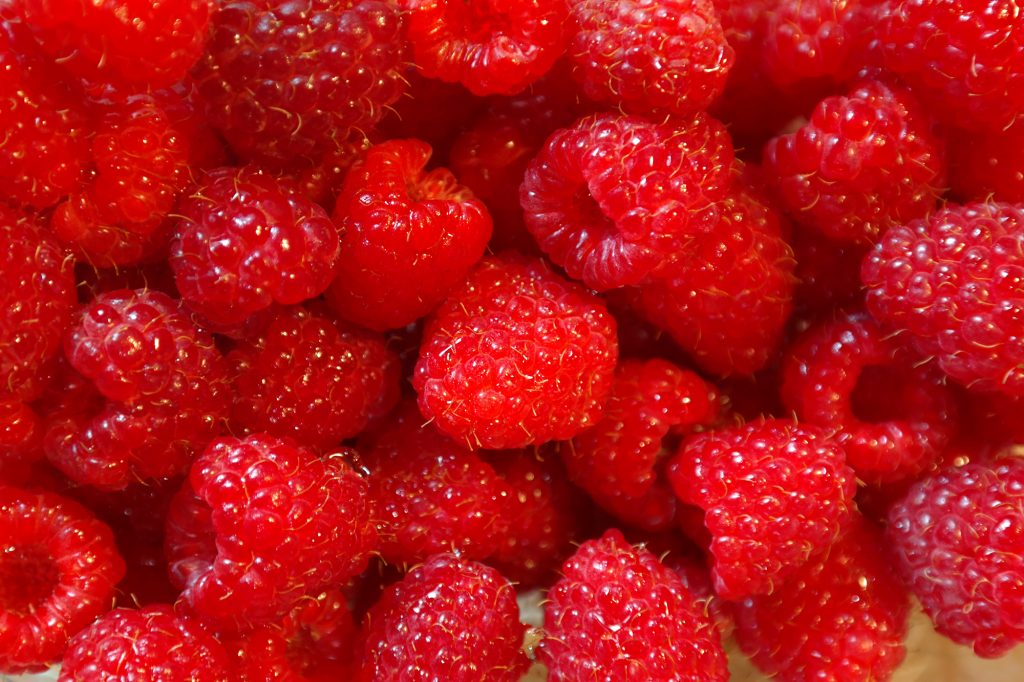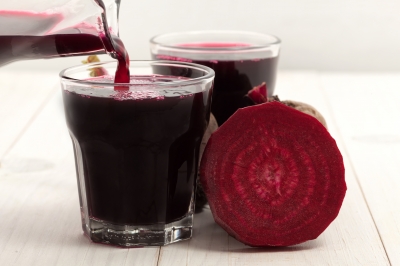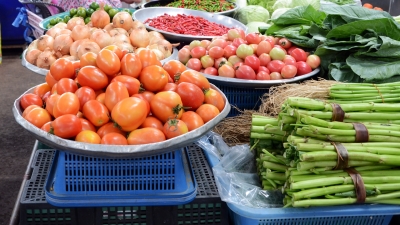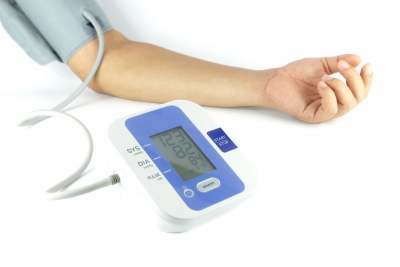Raspberries to Promote Heart Health

Raspberries are low calorie, convenient, great tasting, and provide a variety of nutrients. An excellent addition to your diet.
Fiber to lower cholesterol
Fiber is a key nutrient to combat high cholesterol levels and promote heart health. Dietary fiber binds to cholesterol in circulation and helps remove it from the body. Raspberries provide 12.5 grams/100 kcal (Calories).
For comparison…
High fiber cereals = 6 g fiber/100 kcal
Apple = 4.6 g fiber/100 kcal
Banana = 2.9 g fiber/100 kcal
Grapes = 1.3 g fiber/100 kcal
Most American’s consume about half the daily fiber recommendation of 25 to 35 grams per day. Raspberries are a useful tool for easily increasing your fiber intake. One cup of raspberries provides 8 grams of fiber.
Anthocyanins to lower blood pressure
Endothelial function is compromised with atherosclerotic disease. By providing the body with enhanced oxidative defenses, such as anthocyanins, you increase the nitric oxide released to relax blood vessels leading to vasodilation. This vasodilation promotes lower blood pressure levels. The anthocyanins found in raspberries have been shown to promote vasodilation of blood vessels in studies.
A little chemistry explanation
Quick chemistry lesson so you can better understand a couple terms.
Continue reading
25 Year Cardiology Study Links Prehypertension in Young Adults to Heart Problems Later in Life

Dr. Freeman shares what young adults can do now to prevent heart problems later in life.
What are the results of this 25 year cardiology study linking prehypertension in young adults and heart problems later in life?
Prehypertension can lead to adaptive changes that result in structural alterations in the cardiovascular system, including heart muscle structure, coronary vasculature, and conduction system of the heart over time. Structural changes eventually lead to functional changes resulting in disease: coronary artery disease, angina, myocardial infarction, cardiac arrhythmias, and congestive heart failure.
What does this study mean for young adults?
Continue reading
Dining Out and High Blood Pressure
 Did you know dining out increases your risk for high blood pressure?
Did you know dining out increases your risk for high blood pressure?
Why?
Restaurant foods, whether it be a sit down meal or drive-thru, are typically high in both salt and fat.
A study published in the American Journal of Hypertension is the first to show a direct connection between dining out and high blood pressure.
Up to this point, studies have linked dining out to a higher intake of calories, salt, and saturated fat…all of which are linked to high blood pressure.
Researchers focused on young adults. High blood pressure earlier in life has been associated with future high blood pressure and heart disease risks. Researchers wanted to determine the impact of lifestyle factors on prehypertension and hypertension in young adults.
Prehypertension is defined as a systolic blood pressure between 120-139mm Hg and/or a diastolic blood pressure between 80-89mm Hg. Hypertension — another term for high blood pressure – is defined as a systolic blood pressure greater than or equal to 140mm Hg and/or a diastolic blood pressure greater than or equal to 90mm Hg.
Please note the “and/or” used above. Both numbers do not have to be elevated to be diagnosed with prehypertension or hypertension. If systolic alone is high, that can lead to a diagnosis. If diastolic alone is high the same applies.
Continue reading
Increase Nitric Oxide and Decrease Blood Pressure with Beetroot Juice
 There are many heart disease risk factors, such as high blood pressure and high cholesterol, associated with low nitric oxide levels.
There are many heart disease risk factors, such as high blood pressure and high cholesterol, associated with low nitric oxide levels.
Nitric oxide has many bodily functions, include vasodilation of blood vessels to govern blood pressure.
It was previously believed nitric oxide was only produced via oxidation of L-arginine, an amino acid, in the presence of oxygen. New research has confirmed a second pathway for increasing nitric oxide levels. This second pathway is the conversion of nitrates to nitrite to nitric oxide.
Vegetables are a source of nitrates.
Approximately 85% of dietary nitrate comes from vegetables. The remaining 15% from drinking water. When you consume dietary nitrates, they are absorbed in the stomach and small intestine. Of the ingested nitrates, about 25% is extracted by the salivary glands and concentrated in saliva. It is an enzyme on the surface of the tongue that converts nitrate to nitrite. When the nitrite in saliva is then swallowed it is converted to nitric oxide by the acidic environment of the stomach.
To restate: Nitrate in food becomes nitrite in saliva which then converts to nitric oxide in the stomach.
Nitric oxide obtained from dietary nitrate sources, such as vegetables, provides an alternate treatment plan for increasing protective nitric oxide levels.
Beetroot juice lowered systolic blood pressure 10.4 mm Hg and diastolic blood pressure 9 mm Hg 2.5 – 3 hours after ingestion.
Continue reading
Farmers Markets to Lower Blood Pressure with the DASH Diet

This Dietary Approaches to Stop Hypertension (DASH) diet is recommend to manage high blood pressure. This diet is rich in fruits and vegetables. You need to consume between three to five servings of vegetables daily and between four to five fruits daily. That likely sounds overwhelming, but it can be effective in your efforts to lower blood pressure.
One vegetables serving is equal to 1 cup raw leafy green vegetable, ½ cup cut-up raw or cooked vegetables, or ½ cup vegetable juice.
One fruit serving is equal to 1 medium fruit, ¼ cup dried fruit, ½ cup fresh, frozen, or canned fruit, or ½ cup 100% fruit juice.
It’s the perfect time of year to adopt the DASH diet if you are struggling with high blood pressure. Many varieties of produce are in season and farmers markets are readily available.
3 Benefits of Shopping at Farmers Markets
- Farmers markets are environmentally friendly. The food is produced and sold locally, while food in grocery stores travels an average of 1500 miles before it reaches your plate.
- Produce grown for farmers markets is typically allowed to fully ripen naturally before it is harvested. Nothing is used to speed up the ripening process.
- The produce purchased at a farmers market comes straight from the garden. No processing. This equals fresh and nutrient rich food.
Tips for Shopping at Farmers Markets
Shopping at a farmers market is not the same as going to the grocery store.
Continue reading
Lower Your Blood Pressure without Medication
 Here are 7 ways to lower your blood pressure without medication.
Here are 7 ways to lower your blood pressure without medication.
1. Use a home blood pressure monitor
Monitor your blood pressure at home, as well as your doctor’s office. Combining your readings with your doctor’s will give a better measure of your high blood pressure and treatment to control it. Home monitoring will also rule out if you suffer from “white coat hypertension”. It is ideal to monitor your blood pressure at the same time every day.
Continue reading



